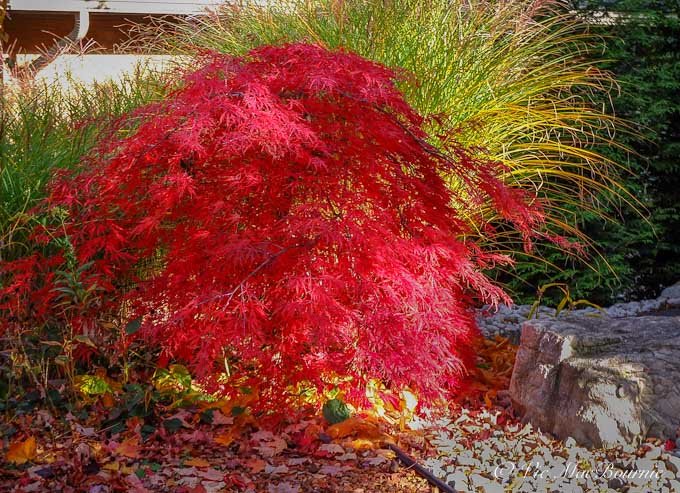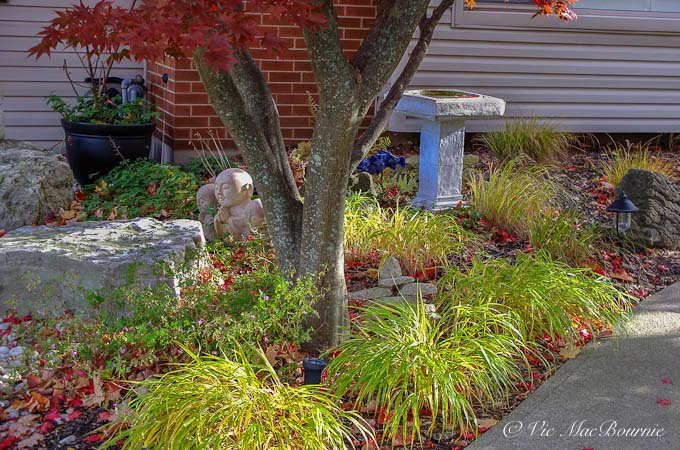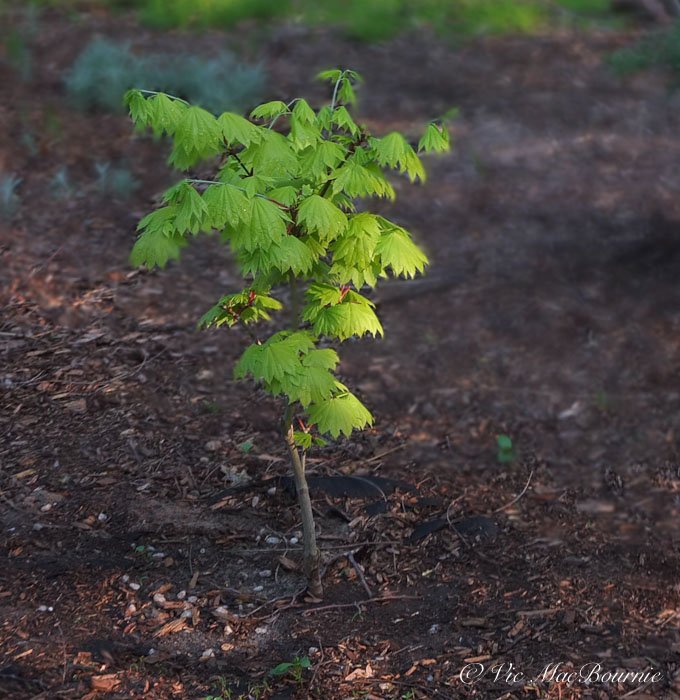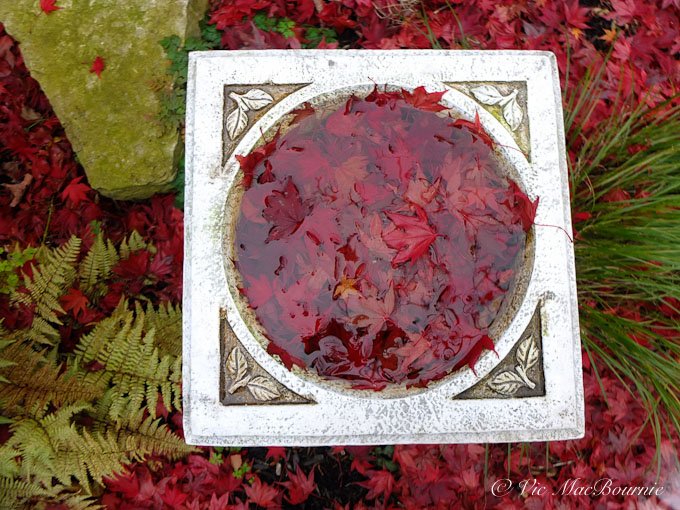How to use Japanese Maples in the landscape
The Japanese Maple is a popular small- to mid-size tree that fits into any landscape, but is especially at home in today’s more compact urban properties.
The enormous selection of varieties available – from the weeping, cutleaf trees that can be tucked into the smallest of spots and are at home in containers, to the full-size acers that add architectural interest and hits of colour to the understory of larger woodland gardens – makes Japanese Maples a staple in today’s landscapes.
There is an incredible variety of Japanese Maples (genus Acer), some that have red/purple leaves, others that feature green leaves and still others that boast a more golden foliage. Some varieties even have a variegated leaf. Many Japanese Maples have a palmatum leaf structure, but some have more lacy, cutleaf foliage that range from mildly serrated to more extreme forms. Some Japanese Maples grow tall (up to 20-25 feet), others are more upright, ideal for narrow areas.
Even the bark of the Japanese Maples vary widely in both colour and textures.
There is definitely a Japanese Maple to fit any and all landscapes.
Japanese maples are generally pest free. Although deer may check them out, they generally leave them alone. I have never experienced a problem with deer in our garden. Male deer, however, have been known to use the smaller trees either to remove antler velvet, or as a sparring partner during mating season. That’s never a good thing for maintaining the shape of your maples.
For more on Japanese Maples and Japanese-inspired gardens, be sure to check out my post on Five tips to create a Japanese-inspired Gardens. For more on the majesty of a mature Japanese Maple and how to care for them in the garden. The weeping Japanese Maple: ideal for yards big and small.
Japanese Maples are relatively slow-growing trees that can easily take 20-25 years to mature into beautiful specimens. The upright varieties can put on maybe a foot of growth a year once they are established, while the smaller weeping varieties might only put on six inches or less.
With this in mind, if you want a large specimen, you might have to invest in a larger (more expensive) specimen from a good nursery.
Don’t be surprised if it takes three or even four years after planting a large specimen to begin showing signs of real growth again. For the first few years after planting, the tree’s roots will be working to settle into their new environment and will put on very little top growth.
If you want to see what your Japanese Maple can become, just take a look at the spectacular Japanese Maple that makes its home in the Portland Japanese garden. (Link to outstanding photos of the tree) Photographers are actually known to make annual pilgrimages to the tree each year in fall just to try and capture its magnificence.
While they are not native to North America, Japanese Maple trees can be an important addition to a woodland garden adding year-round interest to the understory, while providing nesting spots and other benefits for birds and other wildlife.
These stunning trees that grow in zones 5-8, are native to Japan where they have developed many different cultivars, each with their own growing styles. Some golden varieties of Japanese Maples do not do well in the colder zones. If you are looking to add one of these stunning trees, ensure it has extra protection from extreme cold and winds during the winter months.
Used effectively as an understory tree, the larger Japanese Maples can work in landscape plans to form the perfect transition from the height of say, a two-storey home, to the garden’s ground level.
Japanese Maples can be used in containers in the warmer zones (7-8-9) where the containers do not freeze completely.
Do not put prized Japanese Maples in containers in zones 5 and 6a without providing significant winter protection. (I made that mistake and lost two trees during a particularly cold winter.) Consider moving them into a greenhouse if you want to grow Japanese Maples in a container in these colder zones.
The smaller threadleaf weeping varieties of Japanese Maples work beautifully as specimen trees in rock gardens or as part of a water feature reflecting the flowing nature of a waterfalls.
Most of us are familiar with the classic “Bloodgood” variety. These are the larger, hardy red-leaved Japanese Maples that are quite common in neighbourhoods where they have been growing for decades.
How to use Japanese Maples effectively in the landscape
Used effectively as an understory tree, the larger Japanese Maples can work in landscape plans to form the perfect transition from the height of say, a two-storey home, to the garden’s ground level. The building forms a backdrop to show the delicate architecture of the tree. A stucco or light-coloured building, for example, can work beautifully to show off the structure of the tree in all seasons.
The smaller threadleaf weeping varieties of Japanese Maples work beautifully as specimen trees in rock gardens or as part of a water feature reflecting the flowing nature of a waterfalls.
Elsewhere, the mid-size trees are perfect to place a small bench beneath the long horizontal branches to create a focal point in the garden.
The red/purple leaf varieties act as a break from the sea of green in the summer landscape. Consider planting Japanese Forest grass below them for a natural look. All gold Japanese Forest grass works nicely with the Bloodgood maples. In our front garden, I have planted Japanese Forest grass under the large Bloodgood to form a loose groundcover. (You can actually see it in the image below.)
What native trees are good alternatives to Japanese Maple
The traditional Japanese Maple is an elegant, mid-size tree with a horizontal branching habit with interest in all seasons.
That sounds a lot like our native dogwoods, including both the Pagoda Dogwood (cornus alternifolia) and the Flowering Dogwood (cornus florida). Both are excellent native alternatives to the Japanese Maple. For more on Dogwoods, be sure to check out my post on Six of the Best Dogwoods.
Below, is an example of how a smaller sumach tree can be the perfect native alternative to a Japanese Maple. The fall colour on this sumach is absolutely stunning.
Another good alternative is the Mountain maple (Acer glabrum) is a small understory tree that grows between 10-12 feet tall with pink flowers in spring. Its leaves turn bright red in fall not unlike Japanese Maples.
Redbuds, both western redbud (cercis occidentalis) and Eastern redbud (Cercis canadensis) are perfect alternatives to Japanese Maples. Redbuds grow to between 15-30 feet and sports pink flowers in early spring. Check out my post for more on our native redbuds.
Four tips to growing Japanese Maples
Japanese Maples are not difficult to grow but there are steps you can take to ensure their success. They are not an inexpensive tree to plant so anything we can do to give them a good start is a good idea.
When choosing a location, ensure your tree is planted in an area with good drainage. Japanese maples do not like wet feet and their roots could eventually develop root rot and succumb to being planted in a very wet area. The soil should be allowed to dry out between watering. If you must plant a tree in what you think is a wet area, amend the soil as much as possible with sand and grit to promote drainage. Dig a large hole and fill the bottom with stone to keep the roots above water. When you are planting the tree, make sure you plant it an inch or two higher than the soil level to ensure it does not sink into a water-logged bowl.
Do not plant Japanese Maples too deep whether you are planting in a wet area or not. Japanese Maples, like all trees, need oxygen to the roots of the plant. When planting the tree, consider planting it higher than the soil level in the pot it was growing in, especially if you are planting it into a clay-based soil. Create a berm around it so that as it settles into the ground it does not sink below its original soil line. Planting the tree too deep will force the tree to put out feeder roots where the trunk is below ground. Instead of putting on top growth, all its energy will go into putting out root growth where there should not be any. This will slow the tree’s growth and possibly kill it over time. It’s especially important with grafted Japanese Maples. The graft should never be planted below the soil level. It goes without saying that the trees benefit from mulching around the roots but not directly around the trunk of the trees. We’ve all seen the volcano of death style of mulching that almost always leads to a weakened tree and eventual death.
The final set of tips is actually aimed at homeowners trying too hard to create the perfect landscape. I am a strong believer that turf grass should never (or rarely) be grown right up to the trunk of the tree. There are several reasons for this, but among the most critical is the tendency for homeowners, or worse lawn care companies, to injure the tree’s trunk by either hitting it regularly with a lawnmower, or even worse, girdling the trunk with a weedeater. Once the bark around a tree’s trunk is damaged severely, the tree is unable to get food and water up to the main body of the tree leading to eventual weakening and death. This can happen over several years of abuse by the lawnmower or weedeater.
Over fertilization, especially later in the season (June and beyond), can threaten the health of the tree by forcing it to put out too much growth just before the tree goes into hibernation. Extreme cold will then kill off this new growth prior to spring. Japanese Maples are slow growing trees. Have patience. Fertilizing is probably not necessary, but if you do feel you want to add a slow release fertilizer, apply it in early May and keep the nitrogen level low (no more than 15)
Below are two images of a Japanese Maple known as Full Moon Maple (Acer shirasawanum 'Aureum') that never gets large. Fertilizing it will only injure the tree rather than encourage more growth. This link shows a more mature specimen.
This full moon maple (Acer shirasawanum 'Aureum') seen here in early fall is a golden-coloured tree that stays small even in maturity.
Japanese Maples in our woodland garden
In our garden, Japanese Maples take centre stage in both the front and back yards. In the front, three Japanese Maples combine with two full-size maples and a serviceberry to create the upper and lower canopies so important for a woodland style garden. The main Japanese Maple (acer Bloodgood) was the first tree planted in our landscape 25 years ago and welcomes visitors to the pathway leading to the front door.
It has come a long way from the tiny tree I originally planted to a graceful acer that has spread to form a lovely canopy over the walkway. I’ve had to raise the canopy of the tree several times over the years, but I still like to keep it low enough that I’m forced to bend a little to walk beneath its branches.
A second Acer palmatum, (Beni Schichihenge) was added later as a large specimen Japanese Maple that adds a touch of elegance to the landscape and is especially striking in its autumn clothing with its delicate pinkish-orange leaves.
A weeping cutleaf variety adds colour to the Japanese-inspired garden where it softens the hard-edge of the large boulders that grounds the one side of the garden.
Together, they form a triangle in the front landscape that helps to bring a cohesion to the front garden adding colour to the spring, summer and fall landscapes.
There is no denying that Japanese Maples steal the show in fall when their vibrant colours shine through for a number of weeks before they shed their colourful leaves, sometimes all at once following a frosty morning.
On those days, the leaves from our main Japanese Maple form an incredible carpet of crimson red leaves making for the most perfect groundcover for a number of days before they begin to dry out and curl up.
How to grow Japanese Maples
It’s important to remember that Japanese Maples are understory trees, meaning that they do not like to receive full sun for the greater part of the day. Doing so will likely cause the leaves to burn as the summer heat is turned up.
In colder zones such as zones 5-6, Japanese Maples may be able to take more direct sun, but in the hotter zones it is imperative to grow the trees in partial shade and keep them away from mid-day and afternoon sun.
Some direct light results in better colour for many of the varieties.
Japanese Maples can handle heat, it’s the sun that will burn the leaves. New foliage is especially susceptible to burning. Depending on where you are, a couple hours of morning sun is fine but going beyond 1 pm in full sun will likely begin to do damage to the health of these trees.
Make sure they are protected later in the day when the sun is at its strongest. This is especially true in very hot locations.
Salt can also cause the Japanese Maple leaves to burn, whether the salt is in the air near oceans or if your area has hard water. By adding a little gypsum to the soil at planting, the minerals in the water will be leached out. Top dressing the soil around the roots with a little gypsum can also help.
Japanese Maples, like most maples, benefit from deep watering, especially in hot climates or in the heat of summer. While they would not be considered a deep-rooted tree, they are not shallow rooted either.
Deep watering also helps flush out salts that build in the soils.
For more on deep watering, check out my post Why is the Tree in my Front Garden Dying.
When to prune Japanese Maples
It’s best to prune Japanese Maples in either winter or summer. Pruning them in the spring will remove the beautiful new growth that make these trees stunning in early spring and summer.
Winter is an ideal time because you can see the shape of the tree best and work with the branch structure to enhance its architectural interest.
Japanese Maples should never be sheered or shaped into a ball. They are meant to be elegant trees with long horizontal branches that lend a delicate look to them. Their growth pattern is not unlike many of our native dogwoods that like to spread out horizontally.
If you are unsure about how best to prune Japanese maples to enhance their inherent beauty, consider hiring a trained arborist who understands how to properly prune these trees to enhance their inherent qualities.
A typical tree service, known more for cutting down trees, might not be the best to use for pruning your Japanese Maples.
Can you grow Japanese Maples from cuttings?
Take cuttings from spring growth when it is still flexible and not quite what you would called woody.
Put them in a glass of water immediately, before putting them into potting soil with plenty of perlite and a little rooting hormone if possible.
Strip off a number of leaves to create nodes. This is where the roots will eventually emerge.
Keep the cuttings well watered and misted throughout the spring and you could be blessed with new trees perfect for creating bonsai specimens.
Planting a Japanese Maple
One of the keys to getting the perfect Japanese Maple is to pay particular attention to the shape of the tree before setting it into the ground.
Japanese Maples like neutral to slightly acidic soils so start with a good draining soil mix and consider adding a little acidifier to the soil – a good azalea or rhododendron mix would work well. If you have hard water in your area, a little gypsum in the planting hole will help remove some of the minerals in the water. Add just a small amount, maybe 2-3 per cent.
Backfill the soil about halfway and then water in the tree to ensure it gets a good start. At this point you could add a couple handfulls of a mild fertilizer in a 5-3-1 ratio.
Continue backfilling around the tree until the soil is an inch or two below where the soil level was in the pot. Give it another good watering and then add mulch to lock in the moisture in the soil and protect it from direct sun.










